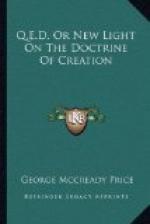With his usual vigor and expressiveness Henry Drummond has given us a picture of the remarkable fact that the cells of all plants and animals are strikingly alike, especially the single cells from which all originate. It is easy for any one to distinguish between an oak, a palm tree, and a lichen, while a botanist will have elaborate scientific distinctions which he can discern between them. “But if the first young germs of these three plants are placed before him,” says Drummond, and the botanist is called upon to define the difference, “he finds it impossible. He cannot even say which is which. Examined under the highest powers of the microscope, they yield no clue. Analyzed by the chemist, with all the appliances of his laboratory, they keep their secret.
“The same experiment can be tried with the embryos of animals. Take the ovule of the worm, the eagle, the elephant, and of man himself. Let the most skilled observer apply the most searching tests to distinguish the one from the other, and he will fail.
“But there is something more surprising still. Compare next the two sets of germs, the vegetable and the animal, and there is no shade of difference. Oak and palm, worm and man, all start in life together. No matter into what strangely different forms they may afterwards develop, no matter whether they are to live on sea or land, creep or fly, swim or walk, think or vegetate,—in the embryo, as it first meets the eye of science, they are indistinguishable. The apple which fell in Newton’s garden, Newton’s dog Diamond, and Newton himself, began life at the same point."[10]
In these remarks, of course, Drummond is dealing with the unicellular primal form, “as it first meets the eye of science”; and while certain slight peculiarities (such as the constant number of chromosomes) have been detected as characteristic of the cells of certain forms, yet for all practical purposes these words of Drummond are just as true to-day as when first written. Possibly it is because of a failure in our technique or from a lack of power in our microscopes that these wonderful protoplasmic units from which all living things originate seem identical. But it is equally possible that they are really identical in structure and in chemical composition, and that only the ever present watchcare of the great Author of nature directs the one to develop in a certain manner, “after its kind,” and another in still another manner, “after its kind.” At any rate, the protoplasm of which they are all alike composed is identical wherever found, so far as any scientific tests have yet been able to determine.
[Footnote 10: “Natural Law,” Chapter X.]
II
There are many varieties of single cells known to science which maintain an independent individual existence. Among the unicellular plants are the bacteria, while the unicellular animals are known as the protozoa. And although perhaps I ought to apologize to the reader for seeming to anticipate here a part of the discussion of the problem of “species,” yet it seems necessary to say a few words here regarding the “persistence” of these unicellular forms.




